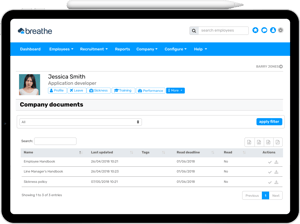Could workplace autonomy be one of the clearest indicators of company culture out there? It’s possible.
A high level of autonomy at work shows a culture where owners and managers trust their teams to do their best.
In contrast, organisations with low levels of autonomy typically have little trust in their staff.
It’s the embodiment of Theory Y management vs. Theory X management that social psychologist Douglas McGregor developed in the 1960s.
What is autonomy at work?
Autonomy at work refers to how much freedom your employees have while they’re working.
Actual levels of autonomy and empowerment vary a lot, even within an organisation.
There are roles that tend to have a higher level of autonomy, such as sales roles. There are also roles where lower autonomy is the norm out of necessity. Take lab testing or production line work, for example.
3 benefits of an autonomous team
They're easier to manage
Let’s start by saying that an autonomous team can be every business owner’s dream.
They’re easier and less time-consuming to manage - and that’s not just our opinion. Dustin Jundt, an organisational psychologist, says that greater team autonomy can contribute towards lower turnover and higher levels of creativity, innovation, and even performance.
Better results
And if that wasn’t appealing enough, consider this. Post-it notes were developed during the inventor’s ‘15% time’ at 3M; an opportunity every employee has to ‘chase rainbows and create their own ideas’. It’s a prime example of autonomous working delivering exceptional results.
Free up time
Yes, autonomous working means better results, improved job satisfaction and better employee engagement. And better employee engagement is a doorway to better retention, lower absence rates and easier talent attraction.
But that’s not all. By making your employees more self-sufficient, you free up time for managers, giving them the chance to work on value-adding tasks.
Building more autonomy into your workplace sounds like a please-all solution. But it’s not always simple. Not only may your team find autonomy uncomfortable to start with, but you as a manager or owner may feel uneasy passing extra control over to others.
In this article we’re listing seven ways you can encourage autonomy at work without feeling like you’re losing your grip on your business.
12 ways Breathe can help
your business during
the COVID-19 crisis
7 ways to encourage autonomy at work
1. Create & communicate a clear vision & purpose
Communicate your vision and purpose and you’re on your way to a more autonomous workplace.
If your team knows what they’re working towards, they can use that knowledge to support their decisions.
Without a clear direction, your employees may make poor choices which means you need to jump in to set things right. It may also mean they work at odds with one another, leading to conflict.
A lack of clear direction will increase your team’s reliance on you or their managers to tell them whether something is aligned with the business plan. Get clear from the outset and consistently reinforce your goals for best results.
2. Give your employees the tools they need
Steve Jobs once said,
“It doesn’t make sense to hire smart people and tell them what to do.”
And we agree.
Too often, problems arise when business owners and managers specify not what must be done, but how.
It tells your team you don’t fully trust their judgement or abilities. It’s hardly motivating, and if they don’t leave, they’ll lose their spark – the reason you hired them in the first place.
Instead, give your team the tools to achieve their goals and help them find their own ‘how’. This includes tools like checklists, the right software, high-quality training and a budget to hire more talent.
Work with your people and be clear about what needs sign-off from you. Doing this means only the relevant details – such as extra spend, external communications and exceptions to previously agreed plans – come to you.
Everything else, so long as it’s to an agreed plan, can be implemented without manager sign-off. Doing this shows your team that you believe in their judgement, and that’s hugely motivating.
3. Take a step back
One of the most challenging - but also most effective ways - of developing autonomy in your team is to occasionally leave them to their own devices. Sound unsettling? Hear us out.
Being unavailable forces your team to work things out on their own and helps them build confidence in their independence.
You don’t need to leave the country or change your phone number. Instead, implement the occasional ‘do not disturb’ time. Why not work from a library for the afternoon or meet with your coach offsite?
Doing so once in a while and giving your team overt permission to deal with problems in your absence will help them and your business flourish in the long term.
4. Support a Growth Mindset
Fearing mistakes kills employee initiative, engagement and autonomy. The most successful organisations focus on learning from their mistakes and foster a growth mindset.
Mistakes are going to happen, what’s important is that you and your team use those mistakes to work out what you can do differently next time.
It’s also important to focus on what you do well. In the same way that athletes who “visualise the win” outperform those who don’t, focusing on what went well after, for example, a successful launch or a bonus sales month will help your team get comfortable with success. The more your team understands what it takes to perform at a higher level, the higher your team’s chances of repeating that success.
5. Hire the right people
Some people are happier being autonomous than others.
This might be because of their personalities or because of the type of culture they’re used to working in.
Get a step ahead by hiring people who are confident with autonomy and who can role-model that behaviour to your other staff.
6. Support professional development
Development plans and career conversations can help your employees take control of their own development and become more autonomous.
Help them fill their skills gaps and they’ll be able to do their jobs more successfully. It’s good news for you and good news for them; you get more accomplished employees, and they feel more engaged because they know you’re interested in their development.
Make sure your managers help their teams with personalised development plans; a one-size-fits-all training plan doesn’t address individual skills gaps. And that means you won’t reap the benefits of an engaged workforce.
7. Think more broadly
Remember that autonomy at work isn’t limited to the tasks your employees do day in, day out. Even in the most prescriptive roles, you can provide autonomy in other parts of their jobs. For example:
- Working hours – a flexible working policy that lets your staff do their jobs on a schedule that suits their home life is proven to drive employee engagement.
- Benefits – providing a range of benefits to choose between can help employees feel more in control.
- Holiday allowance – Limitless holidays or the ability to buy or sell holidays tells employees that you trust them.
- Location – can your employees work from home on a regular or occasional basis? Or do you have several locations which they can choose between? Giving them the choice is an important indicator of your trust.
There we have it, 7 ways you can move towards a more autonomous workplace culture.
It’s not the sort of thing you can do overnight, so give it time. You’ll soon be rewarded with a more motivated team who go above and beyond their job descriptions.

Author: Laura Sands
Laura is a writer who enjoys getting into the detail of subjects and sharing that knowledge with snappy, interesting content. When not typing away, she enjoys walks in the woods and curling up with a good book and mug of something hot.





